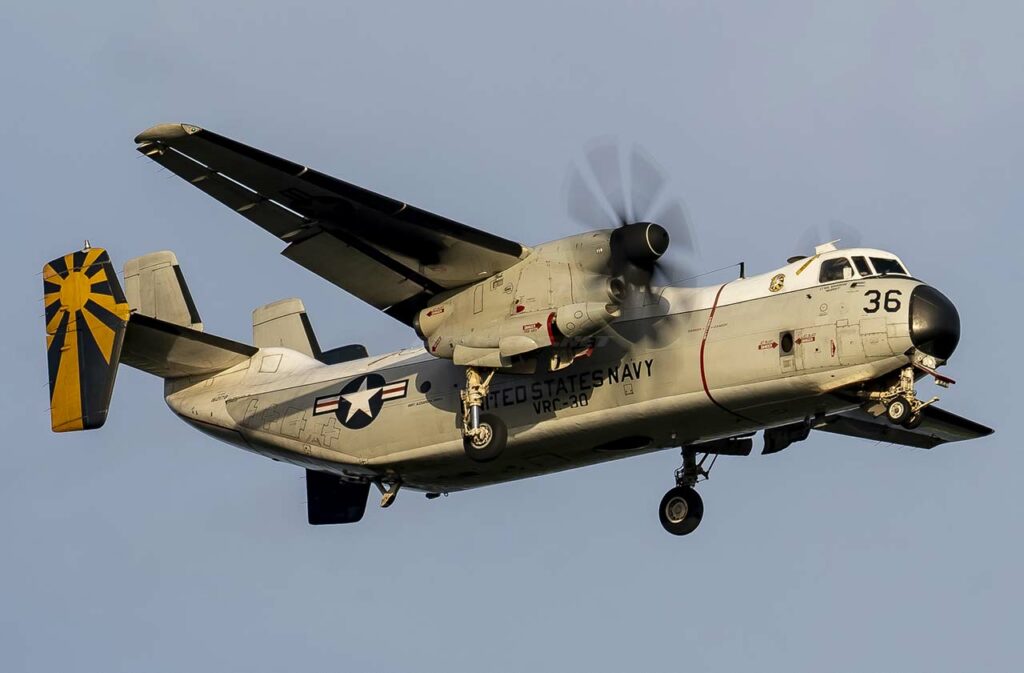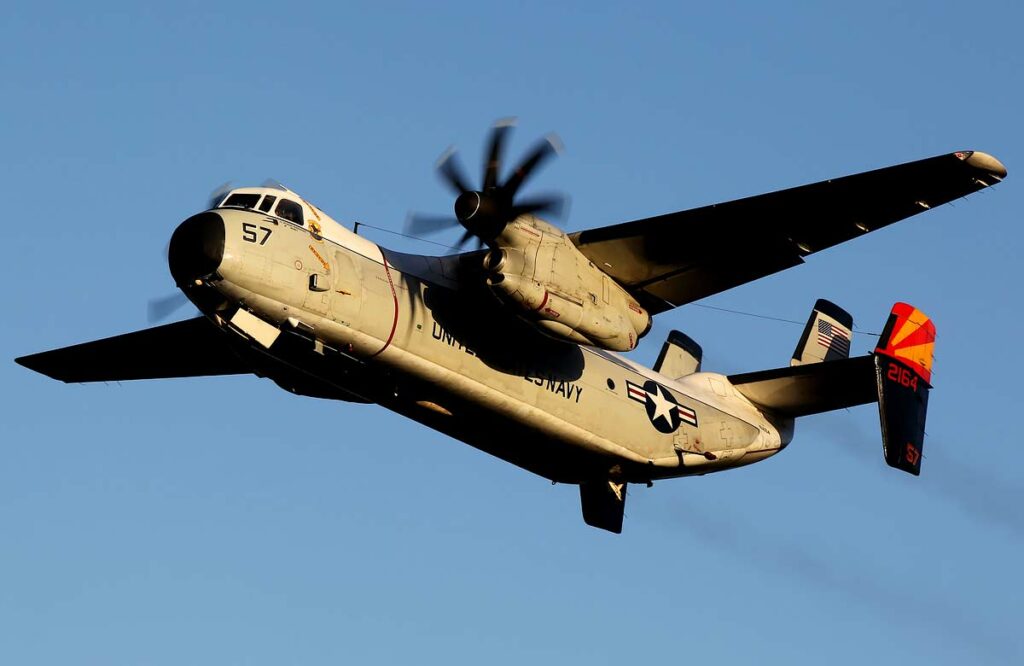The Grumman C-2 Greyhound is a high-wing, twin-engine cargo aircraft, primarily used by the U.S. Navy for carrier onboard delivery (COD) missions.
In brief
The Grumman C-2 Greyhound, a tactical cargo aircraft derived from the E-2 Hawkeye, is tailored for the carrier onboard delivery role, providing critical logistics support to aircraft carriers. Its design allows for the transportation of high-priority cargo, mail, and personnel between carriers and shore bases. Equipped with twin Allison T56-A-425 turboprop engines, it boasts notable short takeoff and landing capabilities, essential for operations from aircraft carriers. The C-2’s rear cargo ramp and on-board cargo handling systems facilitate quick turnaround for cargo and passenger loading/unloading. With a payload capacity of 10,000 pounds, range over 1,300 nautical miles, and the ability to carry up to 26 passengers or stretchers, the Greyhound is a vital logistics link in naval aviation.
The Grumman C-2 Greyhound serves as the U.S. Navy’s primary carrier onboard delivery (COD) aircraft, a critical component for maintaining the operational readiness of carrier strike groups by ensuring the timely delivery of cargo, mail, and personnel.

History of the Development of the Grumman C-2 Greyhound
The development of the C-2 Greyhound was initiated in the early 1960s to address the U.S. Navy’s need for a dedicated Carrier Onboard Delivery (COD) aircraft. The existing COD platforms lacked the efficiency and capacity to meet the logistical demands of modern naval operations. Grumman, leveraging the success of its E-2 Hawkeye, proposed a modified design that would optimize cargo capacity while maintaining robust carrier operational capabilities.
The program’s objective was clear: to create an aircraft capable of rapidly transporting cargo, mail, and personnel between shore bases and aircraft carriers, thus enhancing the fleet’s operational flexibility and logistical responsiveness. The C-2 Greyhound first took to the skies on November 18, 1964, offering an unprecedented combination of range, payload, and carrier operability, tailored to the unique demands of naval aviation logistics.
Design of the Grumman C-2 Greyhound
The design of the C-2 Greyhound incorporates several features optimized for the COD role. It shares the high-wing layout and T-tail configuration with its predecessor, the E-2 Hawkeye, which provides stability and lift efficiency, crucial for carrier-based operations. The aircraft is powered by two Allison T56-A-425 turboprop engines, delivering reliable performance and fuel efficiency.
Significant design considerations include its large cargo bay, rear loading ramp, and foldable wings, which facilitate ease of storage on aircraft carriers. The cargo bay is configured to maximize space utilization, enabling it to carry up to 10,000 pounds of cargo or up to 26 passengers. The onboard cargo handling system and wide rear ramp allow for rapid loading and unloading, essential for time-critical missions. The C-2’s reinforced landing gear and robust airframe are designed to withstand the rigors of catapult launches and arrested landings on carriers.
Performance of the Grumman C-2 Greyhound
The C-2 Greyhound is engineered for exceptional performance in its COD role, with a maximum payload capacity of 10,000 pounds and a range exceeding 1,300 nautical miles, ensuring that logistical supplies can be delivered efficiently across vast oceanic distances. It can cruise at speeds up to 300 knots, with operational altitudes up to 30,000 feet, optimizing fuel efficiency and mission effectiveness.
The aircraft’s short takeoff and landing capabilities, combined with its ability to operate in diverse weather conditions, make it indispensable for carrier strike groups. Compared to its contemporaries, the C-2 Greyhound stands out for its specialized carrier-based operational design, offering unmatched capabilities in the COD role that other cargo aircraft cannot provide.
Variants of the Grumman C-2 Greyhound
The C-2 Greyhound has undergone various updates and modifications, resulting in multiple variants:
- C-2A: The initial production version, providing essential COD capabilities with improvements over time to avionics and systems.
- C-2A(R): An upgraded version with structural enhancements, modernized avionics, and improved cargo handling features, extending the airframe’s service life and operational efficiency.
These variants reflect the evolutionary improvements made to enhance the Greyhound’s reliability, safety, and mission adaptability.

Military Use and Combat of the Grumman C-2 Greyhound
The C-2 Greyhound, while not a combat aircraft, plays a crucial role in the operational effectiveness and sustainability of carrier strike groups. Its primary mission is logistical support, ensuring the timely delivery of essential supplies, mail, and personnel to aircraft carriers at sea. The aircraft has been pivotal in numerous military operations, demonstrating its value in rapid response situations, humanitarian aid, and disaster relief efforts, where its capacity to quickly transport critical supplies and personnel has had a significant impact.
The Greyhound’s operational history underscores its importance in maintaining the combat readiness and logistical support of naval aviation forces, underlining its indispensable role in modern military operations.
The Grumman C-2 Greyhound epitomizes the vital role of logistics in modern naval operations, offering unmatched capabilities in the Carrier Onboard Delivery role. Its design, performance, and operational versatility have made it an indispensable asset to the U.S. Navy, proving its worth across decades of service. The Greyhound’s enduring operational relevance highlights its significance in ensuring the logistical sustainment and readiness of carrier strike groups, solidifying its legacy in naval aviation history.
Back to Transport planes.